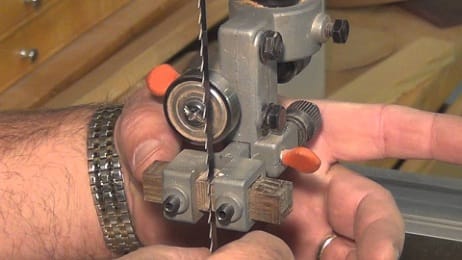As an Amazon Associate, I earn from qualifying purchases.

If you’re looking to work with wood, a bandsaw is an essential tool to have in your workshop. But before you can start making clean cuts and intricate shapes, you’ll need to know how to set up your bandsaw properly. In this guide, we’ll take you through the steps of setting up your bandsaw so you can start using it effectively.
How To Set Up A Bandsaw?

Choose the Right Blade
The first step in setting up your bandsaw is to choose the right blade for the job. Bandsaw blades come in a variety of widths and tooth configurations, so you’ll need to choose one that’s appropriate for the type of cutting you’ll be doing. For general-purpose cutting, a 1/2-inch, 3 TPI (teeth per inch) blade is a good choice. For resawing, a wider blade with fewer TPI is better, such as a 3/4-inch, 2 TPI blade.
Adjust the Blade Guides
The blade guides are an important part of your bandsaw setup. They help keep the blade aligned and reduce vibration, which can result in cleaner cuts. The guides should be adjusted so they’re just touching the blade, but not pushing it to one side or the other. You may need to adjust both the upper and lower guides.
Set the Blade Tension
Proper blade tension is critical for getting good cuts and prolonging the life of your blade. To set the tension, turn the tensioning knob until the blade is tight enough that you can pluck it like a guitar string without it flopping around, but not so tight that it feels like a banjo string.
Adjust the Blade Tracking
Blade tracking refers to the way the blade runs on the wheels. It should run in the center of the wheel, with the teeth facing forward. To adjust the tracking, turn the tracking knob until the blade is running in the center of the wheel.
Adjust the Blade Angle
The blade angle, or tilt, can be adjusted to make angled cuts. To adjust the angle, loosen the blade tension and tilt the table to the desired angle. Then, retighten the blade tension.
Set the Blade Height
The blade height is another important factor in getting accurate cuts. The blade should be set just high enough that it clears the workpiece, but not so high that it’s exposed above the workpiece. To adjust the blade height, use the height adjustment knob or crank.
Adjust the Fence
The fence is used to guide the workpiece as it’s being cut. It should be adjusted so it’s just touching the blade, but not pushing it to one side or the other.
Check the Table Alignment
The table should be aligned with the blade so that the workpiece is supported properly and the blade cuts straight. To check the alignment, use a straight edge to see if the table is level and parallel to the blade.
Check the Blade Guard
The blade guard is an important safety feature that helps protect your fingers from the blade. Make sure it’s in place and functioning properly before using your bandsaw.
Test Your Setup
Once you’ve made all the adjustments, it’s time to test your setup. Start with a scrap piece of wood and make a few test cuts to make sure everything is working properly. If you notice any issues, go back and adjust as needed.
Safety Tips
Working with a bandsaw can be dangerous if proper safety precautions aren’t taken. Always wear safety glasses, and consider wearing a dust mask and hearing protection as well. Keep your fingers and loose clothing away from the blade, and never reach over the blade while it’s running.
Maintenance Tips
To keep your bandsaw in good working condition, it’s important to perform regular maintenance. This includes cleaning the blade and wheels, lubricating moving parts, and checking the blade tension and alignment.
Common Problems And Solutions
If you’re having trouble with your bandsaw, there are a few common problems that could be causing issues. For example, if you’re experiencing blade drift, it could be due to improper blade tension or tracking. Check your setup and make adjustments as needed.
FAQs

How do I know which blade to use for a particular job?
It depends on the type of cutting you’ll be doing. For general-purpose cutting, a 1/2-inch, 3 TPI blade is a good choice. For resawing, a wider blade with fewer TPI is better, such as a 3/4-inch, 2 TPI blade.
How do I adjust the blade guides?
The guides should be adjusted so they’re just touching the blade, but not pushing it to one side or the other. You may need to adjust both the upper and lower guides.
How do I adjust the blade angle?
To adjust the angle, loosen the blade tension and tilt the table to the desired angle. Then, retighten the blade tension.
How do I keep my bandsaw in good working condition?
Regular maintenance is key. This includes cleaning the blade and wheels, lubricating moving parts, and checking the blade tension and alignment.
How do I stay safe while using a bandsaw?
Always wear safety glasses, and consider wearing a dust mask and hearing protection as well. Keep your fingers and loose clothing away from the blade, and never reach over the blade while it’s running.
Conclusion
Setting up a bandsaw can seem daunting, but with a little know-how, it’s a straightforward process. Follow these steps to get your bandsaw up and running, and you’ll be making clean cuts in no time.



